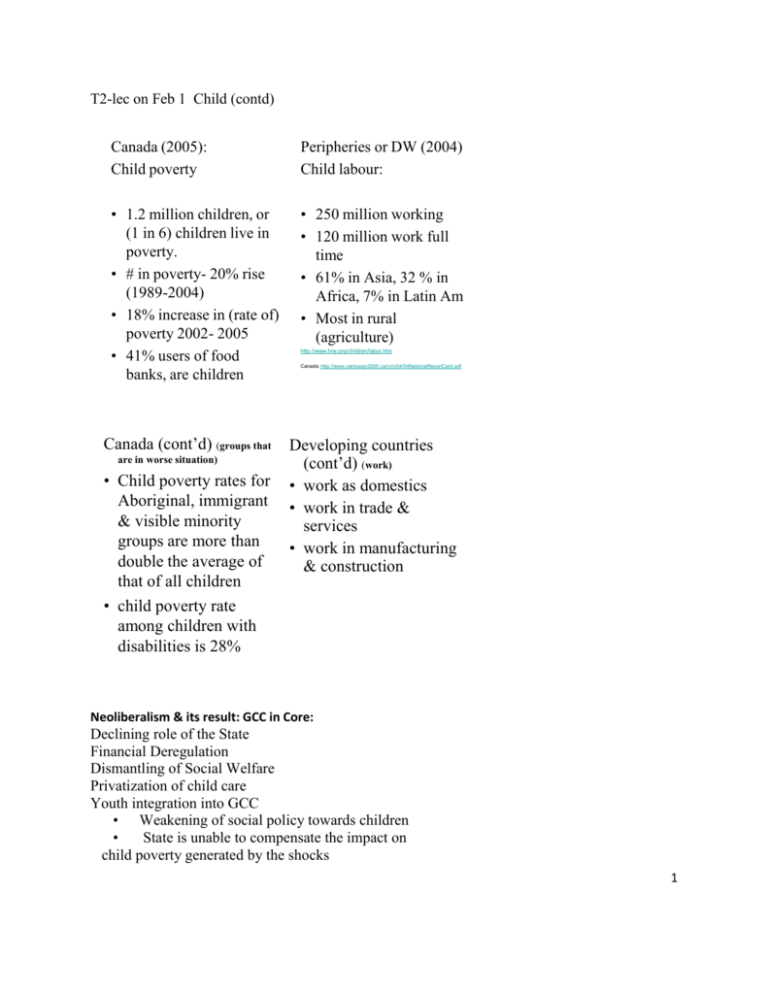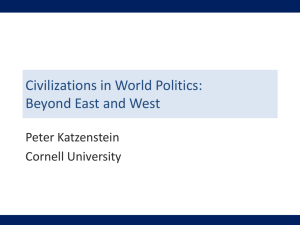T2-lec on Feb 1 Child (contd) Neoliberalism & its result: GCC in
advertisement

T2-lec on Feb 1 Child (contd) Canada (2005): Child poverty Peripheries or DW (2004) Child labour: • 1.2 million children, or (1 in 6) children live in poverty. • # in poverty- 20% rise (1989-2004) • 18% increase in (rate of) poverty 2002- 2005 • 41% users of food banks, are children • 250 million working • 120 million work full time • 61% in Asia, 32 % in Africa, 7% in Latin Am • Most in rural (agriculture) Canada (cont’d) (groups that are in worse situation) • Child poverty rates for Aboriginal, immigrant & visible minority groups are more than double the average of that of all children • child poverty rate among children with disabilities is 28% http://www.hrw.org/children/labor.htm Canada: http://www.campaign2000.ca/rc/rc04/04NationalReportCard.pdf Developing countries (cont’d) (work) • work as domestics • work in trade & services • work in manufacturing & construction Neoliberalism & its result: GCC in Core: Declining role of the State Financial Deregulation Dismantling of Social Welfare Privatization of child care Youth integration into GCC • Weakening of social policy towards children • State is unable to compensate the impact on child poverty generated by the shocks 1 • • Declining funding for youth programs & educ. Youth unemployment Canada: Source: http://dsp-psd.tpsgc.gc.ca/Collection-R/LoPBdP/CIR/824-e.htm Topic 2: Framework on Women and development : WST & Commodity Chain: • Financial Crisis: Neoliberal deregulation policies (Canadian Women) • Global Commodity chain (GCC) (Third World Women) Why & how Canadian women workers are disadvantaged? Canadian neoliberal policies/practices legitimize the extraction of surplus from temps & low waged women workers Concepts & arguments: • • Caragata (2003): gendered and differential benefits; labour force changes; marginalization; retrenching welfare state; commodification of social roles. Quintero-Ramirez (2002): capital mobility; flexible work & vulnerable for firing; feminization of labour. Canadian Women: Neoliberal policies • Liberalization: Free trade • Austerity: Financial cutbacks • Privatization: For profit services replace public services and dismantling of unions • Deregulation of: Financial procedures and securities of lending, borrowing and insurance; Flow of foreign investment • Globalization of production & expansion of market What is Feminization (Canadian Women workers) • Women’s high labour force participation and employment rates 2 • Gendered rise of insecure or temp jobs Capital extracts surplus: From: Canada: lower cost of production (e.g. corp get subsidies: lower corp tax; universal medical care) Mexico: cheap labour - Export Promoting Zones (EPZ) or border industrialization, e.g., Maquiladora maquila, portion received by the miller in return for milling one's grain, Women in the ‘Core’: In Low-Paid Employment (% Labour Force) (Caragata: 2003) Country (year) Total Men Women Australia (1995) Canada (1994) France (1994) Sweden (N/A) UK (1995) US (1994) 13.8 23.7 13.3 5.2 19.6 25.0 11.8 16.1 10.6 3.0 12.8 19.6 17.7 34.3 17.4 8.4 31.2 32.5 Canada: women’s problems are not related to basic needs (as in poorer countries) Core countries: Indigenous women: • education and life expectancy world's lowest rates • illiteracy, infant and maternal mortality and death from preventable disease world’s highest rates • Global Commodity chain (Third World Women) Arguments (DW# 42 to 45) http://www.ipsnews.net/news.asp?idnews=45965 study released by the Paris-based U.N. Educational, Scientific and Cultural Organisation (UNESCO) UNITED NATIONS, Mar 3, 2009 (IPS) Peripheral countries: GCC: Reasons why women are marginalized: Women are treated as commodities/property by: 1. Traditions (DW # 43) 2. Religious fundamentalism (DW # 42, 45) 3 3. Socio-political Status (DW 44) 4. Market (Women in GCC) (Essay sub-concepts to use) Topic 3: Terrorism, ethnic conflicts and global development: the impact of terrorism/ethnic conflicts on development in the Third World and that in the First World: Why endless conflicts in the periphery? WST identifies Core’s policies/actions as causes: • Hegemonic extraction of poor nation’s natural resources (DW #19) • Entrenched poverty & exploitation of the global poor/refugees (#21) • End of cold war (#18, 20) • Delegitimization of the State in the periphery (# 22 to 26) DW: #18: End of the Cold War combined with many LDCs have weak states and incapacitated governments #19: Extraction of resources and land from the Islamic middle east has created internal conflicts and global terrorism: dominant religious group in Saudi Arabia are the puritan Wahhabis – Hezbollah leader declare d:“anyone using a firearm against a Lebanese brother is working for Israel.” Al Qaeda is dogmatically anti-Shiite #20: Afghanistan believes Taliban leadership will be back in power. It is one of the poorest countries in the world - provides 92 percent of the world’s heroin. Islamist warlords have established a Taliban front in Afghanistan. Pakistani military is unable to contain Islamic fundamentalism. Many Pashtuns, are Taliban sympathizers. From Quetta, Pakistan, Taliban recruit; organize, import arms and fund-raise #21: Bush Administration’s policy on Darfur and Sudanese oil #22: ethnic violence a result of Kenyan civil society ‘s failure to organize for monitoring corruption in election #23: Mugabe retained power through electoral fraud and intimidation. #24: Continuing crisis include manipulation of clan loyalties, the influence of warlords, leadership failures, and fears of state restoration by some factions. Ethiopia’s links to Al Qaeda. World-system & hegemonic ideologies: “western civilization” (Huntington, 1996) “modernity” (Bell, 1976, Friedman. 1989, Taylor, 2000) “capitalist civilizational project,” (Wallerstein,1983) 1. Economic growth, endless accumulation and profit maximization 2. Commodification of things and people 3. Globally expand and extract surplus 4. Imperialism over ecology and global homogenization 5. Hierarchical inequalities based on Whiteness, racism and sexism Huntington argues 4 1. Trends of global conflict after the end of the Cold War - appearing at the civilizational divisions (see map). 2. Western belief - universality of the West's values and political systems - continued insistence on democratization and such "universal" norms – this further antagonizes other civilizations 3. He identifies a major shift of economic, military, and political power from the West to the other world civilizations - significantly to the two "challenger civilizations", Sinic and Islam 4. He sees Islamic civilization as a potential ally to China, both having more revisionist goals and sharing common conflicts with other civilizations, especially the West 5. Russia, Japan, and India are 'swing civilizations' 6. Civilizational conflicts are "particularly prevalent between Muslims and non-Muslims" see, the "bloody borders" between Islamic and non-Islamic civilizations. Factors contributing to this conflict 1. Missionary religions, seeking conversion by others 2. Universal, "all-or-nothing" religions, in the sense that it is believed by both sides that only their faith is the correct one 3. Teleological religions, i.e., that their values and beliefs represent the goals of existence and purpose in human existence. Critique of H: (many critics): an e.g. Amartya Sen (2006). Identity and Violence: The illusion of destiny, argues: • That a root cause of violence is when people see each other as having a singular affiliation, ie: Hindu or Muslim • Their identities are of multiple affiliations: Hindu, woman, housewife, mother, artist, daughter, member of a particular socio-economic class...etc. all of which can be a source of a person's identity. 5






